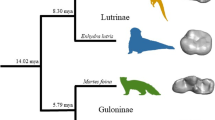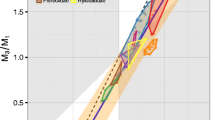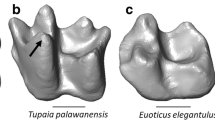Abstract
The dentition can be thought of as comprising a series of functional modules, which may include pre-ingestive food preparation, ingestion, sexual signalling, and mastication. Changes in diet may be manifested in shifts in the boundaries between these modules along the toothrow. In particular, because of their position in the mouth, premolars may act in ingestion and/or mastication of food. With shifts toward masticatory function, premolars may become “molarized”. Although it is common in descriptions of fossil taxa to use terms like “premolarization” and “molarization”, these are rarely clearly defined or linked to quantitative measures. Here, we make use of dental topographic analysis (DTA) of the lower fourth premolar (p4) and lower second molar (m2) to quantify and contextualize molarization in a lineage previously identified as exhibiting increasing p4 molarization through time: the microsyopine microsyopids from the early Eocene of the Bighorn Basin, Wyoming. Increases in premolar size have been cited as evidence of molarization in other groups, so we also measured size of the premolars and molars. Our results are consistent with observations about increasing premolar molarization in microsyopines through time, but we observed no associated change in the topography or function of the molars, nor did we observe an increase in the size of the premolars. Later microsyopid taxa may have relied more heavily than earlier species on fibrous foods such as leaves, a conclusion not evident from the molars alone. In general, claims of “molarization” should consider shifting function alongside observations of changes in size or shape.



Similar content being viewed by others
References
Asahara M (2013) Unique inhibitory cascade pattern of molars in canids contributing to their potential to evolutionary plasticity of diet. Ecol Evol 3:278–285
Ash M, Nelson SJ (2003) The primary (deciduous) teeth. In: Nelson SJ (ed) Wheeler’s Dental Anatomy, Physiology and Occlusion. St. Louis, Elsevier, pp. 45–66
Berthaume MA, Winchester J, Kupczik K (2019) Ambient occlusion and PCV (portion de ciel visible): A new dental topographic metric and proxy of morphological wear resistance. PloS ONE 14:e0215436
Biknevicius AR (1986) Dental function and diet in the Carpolestidae (Primates, Plesiadapiforms). Am J Phys Anthropol 71:157–171
Bloch JI, Silcox MT (2006) Cranial anatomy of the Paleocene plesiadapiform Carpolestes simpsoni (Mammalia, Primates) using ultra high-resolution X-ray computed tomography, and the relationships of plesiadapiforms to Euprimates. J Hum Evol 50:1–35
Bloch JI, Silcox MT, Boyer DM, Sargis EJ. (2007) New Paleocene skeletons and the relationship of plesiadapiforms to crown-clade primates. Proc Natl Acad Sci 104:1159–1164
Bown TM, Kraus MJ (1993) Time-stratigraphic reconstruction and integration of paleopedologic, sedimentologic, and biotic events (Willwood Formation, lower Eocene, northwest Wyoming, USA). Palaios 8:68–80.
Bown TM, Rose KD, Simons EL, Wing SL (1994) Distribution and stratigraphic correlation of upper Paleocene and lower Eocene fossil mammal and plant localities of the Fort Union, Willwood, and Tatman formations, southern Bighorn Basin, Wyoming. US Geological Survey, Professional Paper 1540:1–103
Boyer DM (2008) Relief index of second mandibular molars is a correlate of diet among prosimian primates and other euarchontan mammals. J Hum Evol 55:1118–1137.
Boyer DM, Evans AR, Jernvall J (2010) Evidence of dietary differentiation among late Paleocene-early Eocene plesiadapids (Mammalia, primates). Am J Phys Anthropol 142:194–210
Boyer DM, Gunnell GF, Kaufman S, McGeary T (2016) MorphoSource–Archiving and sharing 3D digital specimen data. J Paleontol 22:157–181
Bunn JM, Boyer DM, Lipman Y, St. Clair EM, Jernvall J, Daubechies I (2011) Comparing Dirichlet normal surface energy of tooth crowns, a new technique of molar shape quantification for dietary inference, with previous methods in isolation and in combination. Am J Phys Anthropol 145:247–261
Burrows AM, Hartstone-Rose A, Nash LT (2015) Exudativory in the Asian loris, Nycticebus: Evolutionary divergence in the toothcomb and M3. Am J Phys Anthropol 158:663–672
Burrows AM, Nash LT, Hartstone-Rose A, Silcox MT, López-Torres S, Selig KR (2020) Dental signatures for exudativory in living primates, with comparisons to other gouging mammals. Anat Rec 303:265–281
Butler PM (1952) Molarization of the premolars in the Perissodactyla. Proc Zool Soc 121:819–843
Charles-Dominique P, Petter JJ (1980) Ecology and social life of Phaner furcifer. In: Charles-Dominique P, Cooper HM, Hladik A, Hladik CM, Pagès E, Pariente GF, Petter-Rousseaux A, Petter JJ, Schilling A (eds) Nocturnal Malagasy primates: Ecology, Physiology and Behaviour. Academic Press, New York, pp 3–38
Chester SGB, Williamson TE, Bloch JI, Silcox MT, Sargis EJ (2017) Oldest skeleton of a plesiadapiform provides additional evidence for an exclusively arboreal radiation of stem primates in the Palaeocene. Royal Soc Open Sci 4:170329
Chew AE (2005) Biostratigraphy, paleoecology and synchronized evolution in the early Eocene mammalian fauna of the central Bighorn Basin, Wyoming. Dissertation, Johns Hopkins University.
Chew AE (2009) Paleoecology of the early Eocene Willwood mammal fauna from the central Bighorn Basin, Wyoming. Paleobiology 35:13–31
Chew AE (2015) Mammal faunal response to the Paleogene hyperthermals ETM2 and H2. Clim Past 11:1371–1405
Evans AR, Daly ES, Catlett KK, Paul KS, King SJ, Skinner MM, Nesse HP, Hublin J-J, Townsend GC, Schwartz GT, et al. (2016) A simple rule governs the evolution and development of hominin tooth size. Nature 530:477–480
Evans AR, Janis CM (2014) The evolution of high dental complexity in the horse lineage. Ann Zool Fenn 51:73–79
Evans AR, Wilson GP, Fortelius M, Jernvall J (2007) High-level similarity of dentitions in carnivorans and rodents. Nature 445(7123):78–81
Fleagle JG, McGraw WS (1999) Skeletal and dental morphology supports diphyletic origin of baboons and mandrills. Proc Natl Acad Sci USA 96:1157–1161
Fleagle JG, McGraw WS (2002) Skeletal and dental morphology of African papionins: unmasking a cryptic clade. J Hum Evol 42:267–292
Fulwood EL, Shan S, Winchester JM, Gao T, Kirveslahti H, Daubechies I, Boyer DM (2021) Reconstructing dietary ecology of extinct strepsirrhines (Primates, Mammalia) with new approaches for characterizing and analyzing tooth shape. Paleobiol 47:612–631
Gingerich PD (1976) Cranial anatomy and evolution of early Tertiary Plesiadapidae (Mammalia, Primates) Univ Mich Pap Paleontol 15:1–141
Gunnell GF (1985) Systematics of early Eocene Microsyopinae (Mammalia, Primates) in the Clark’s Fork Basin, Wyoming. Contrib Mus Paleontol Univ Michigan 27:51–71
Gunnell GF (1989) Evolutionary History of Microsyopoidea (Mammalia, ?Primates) and the relationship between Plesiadapiforms and Primates. Univ Mich Pap Paleontol 27:1–157
Guy F, Gouvard F, Boistel R, Euriat A, Lazzari V (2013) Prospective in (primate) dental analysis through tooth 3D topographical quantification. PloS ONE 8:e66142
Halliday TJ, Goswami A (2013) Testing the inhibitory cascade model in Mesozoic and Cenozoic mammaliaforms. BMC Evol Biol 13:79.
Hammer Ø, Harper DAT, Ryan PD (2001) PAST: Paleontological Statistics Software Package for education and data analysis. Paleontol Electron 4 http://palaeo-electronica.org/2001_1/past/issue1_01.htm
Jernvall J (2000) Linking development with generation of novelty in mammalian teeth. Proc Nat Acad Sci USA 97:2641–2645
Jernvall J, Gilbert CC, Wright PC (2008) Peculiar tooth homologies of the greater bamboo lemur (Prolemur = Hapalemur simus). In: Fleagle JG, Gilbert CC (eds) Elwyn Simons: A Search for Origins. New York: Springer pp 335–342
Jones KE, Rose KD, Perry JMG (2014) Body size and premolar evolution in the early-middle Eocene euprimates of Wyoming. Am J Phys Anthropol 153:15–28
Kavanagh KD, Evans AR, Jernvall J (2007) Predicting evolutionary patterns of mammalian teeth from development. Nature 449:427–432
Koch PL, Clyde WC, Hepple RP, Fogel ML, Wing SL, Zachos JC (2003) Carbon and oxygen isotope records from paleosols spanning the Paleocene-Eocene boundary, Bighorn Basin, Wyoming. Geo Soc Am Spec Pap 369:49–64
Kraatz BP, Meng J, Weksler M, Li C (2010) Evolutionary patterns in the dentition of Duplicidentata (Mammalia) and a novel trend in the molarization of premolars. PloS ONE. 5:e12838
Ledogar JA, Winchester JM, St. Clair EM, Boyer DM (2013) Diet and dental topography in pitheciine seed predators. Am J Phys Anthropol 150:107–121
Li P, Morse PE, Kay RF (2020) Dental topographic change with macrowear and dietary inference in Homunculus patagonicus. J Hum Evol 144:102786.
López-Aguirre C, Czaplewski N, Link A, Takai M, Hand S (2022) Dietary and body mass reconstruction of the Miocene neotropical bat Notonycteris magdalenensis (Phyllostomidae) from La Venta, Colombia. Paleobiol 48:137–153
López-Torres S, Selig KR, Prufrock KA, Lin D, Silcox MT (2018) Dental topographic analysis of paromomyid (Plesiadapiformes, Primates) cheek teeth: more than 15 million years of changing surfaces and shifting ecologies. Hist Biol 30:76–88
Lucas PW (2004) Dental Functional Morphology: How Teeth Work. Cambridge University Press, Cambridge
McGraw WS, Vick AE, Daegling DJ (2011) Sex and age differences in the diet and ingestive behaviors of sooty mangabeys (Cercocebus atys) in the Tai Forest, Ivory Coast. Am J Phys Anthropol 144:140–153
Nash LT, Burrows AM (2010) Introduction: advances and remaining sticky issues in the understanding of exudativory in primates. In Burrows AM, Nash LT (eds) The Evolution of Exudativory in Primates. Springer, New York, pp 1–23
Ni X, Gebo DL, Dagosto M, Meng J, Tafforeau P, Flynn JJ, Beard KC (2013) The oldest known primate skeleton and early haplorhine evolution. Nature 498:60–64
Ni X, Li Q, Li L, Beard KC (2016) Oligocene primates from China reveal divergence between African and Asian primate evolution. Science 352:673–677
Osborn HF (1907) Evolution of Mammalian Molar Teeth. The MacMillan Company, New York
Prufrock KA, Boyer DM, Silcox MT (2016a) The first major primate extinction: An evaluation of paleoecological dynamics of North American stem primates using a homology free measure of tooth shape. Am J Phys Anthropol 159:683–697
Prufrock KA, López-Torres S, Silcox MT, Boyer DM (2016b) Surfaces and spaces: troubleshooting the study of dietary niche space overlap between North American stem primates and rodents. Surf Topogr 4:024005
Schroer K, Wood B (2015) Modeling the dental development of fossil hominins through the inhibitory cascade. J Anat 226:150–162
Selig KR, Chew AE, Silcox MT (2021a) Dietary shifts in a group of Early Eocene euarchontans (Microsyopidae) in association with climatic change. Palaeontology 64:609–628
Selig KR, Khalid W, Silcox MT (2021b) Mammalian molar complexity follows simple, predictable patterns. Proc Natl Acad Sci USA 118:e2008850118
Selig KR, Schroeder L, Silcox MT (2021c) Intraspecific variation in molar topography of the early Eocene stem primate Microsyops latidens (Mammalia, ?Primates). J Vert Paleontol 41: e1995738
Selig KR, Sargis EJ, Chester SG, Silcox MT (2020) Using three-dimensional geometric morphometric and dental topographic analyses to infer the systematics and paleoecology of fossil treeshrews (Mammalia, Scandentia). J Paleontol 94:1202–1212
Selig KR, Sargis EJ, Silcox MT (2019) The frugivorous insectivores? Functional morphological analysis of molar topography for inferring diet in extant treeshrews (Scandentia). J Mammal 100:1901–1917
Selig KR, Silcox MT (2021) The largest and earliest known sample of dental caries in an extinct mammal (Mammalia, Euarchonta, Microsyops latidens) and its ecological implications. Sci Rep. 11:15920.
Shan S, Kovalsky SZ, Winchester JM, Boyer DM, Daubechies I (2019) ariaDNE: A robustly implemented algorithm for Dirichlet energy of the normal. Methods Ecol Evol 10:541–552
Silcox MT, Benham AE, Bloch JI (2010) Endocasts of Microsyops (Microsyopidae, Primates) and the evolution of the brain in primitive primates. J Hum Evol 58:505–521
Silcox MT, Selig KR, Bown TM, Chew AE, Rose KD (2021) Cladogenesis and replacement in the fossil record of Microsyopidae (?Primates) from the southern Bighorn Basin, Wyoming. Biol Lett 17:20200824
Simpson GG (1933) The “plagiaulacoid” type of mammalian dentition. A study of convergence. J Mammal 14:97–107
Szalay FS. 1969. Mixodectidae, Microsyopidae, and the insectivore-primate transition. Bull Amer Mus Nat Hist 140:193–330
Ungar P (2004) Dental topography and diets of Australopithecus afarensis and early Homo. J Hum Evol 46:605–622
Ungar PS (2010) Mammal Teeth: Origin, Evolution, and Diversity. Baltimore, Johns Hopkins University Press
Van Valen LM (1982) Homology and causes. J Morph 173:305–312
Visualization Sciences Group (2009) Avizo. Burlington, Mercury Computer Systems
Winchester JM (2016) MorphoTester: An open source application for morphological topographic analysis. PloS ONE 11:e0147649
Winchester JM, Boyer DM, St. Clair EM, Gosselin-Ildari AD, Cooke SB, Ledogar JA (2014) Dental topography of platyrrhines and prosimians: Convergence and contrasts. Am J Phys Anthropol 153:29–44
Acknowledgements
We thank Justin Gladman and Sergi López-Torres for help micro-CT scanning the material, Derrick Lin for help in prepping the micro-CT scans for analysis, and Jade Abdul-Sater for tirelessly uploading scans to MorphoSource. We also thank the curators and collections staff of the University of Wyoming, the Yale Peabody Museum, the Smithsonian, the Duke Fossil Primate Center, and the United States Geological survey for access to materials, and to T.M. Bown for access to unpublished stratigraphic data. We thank the NSF and National Geographic Society for field work support to Ken Rose (NSF grants BSR-8500732, BSR-8918755, IBN-9419776, EAR-0000941, and EAR-0616376) and Amy Chew (NSF grants, SGP-0739718 and SGP-0616430, and National Geographic Society Waitt Program 172 grant W315-14). Funding for this project was provided by a Pilot Research Grant to KRS from the Department of Anthropology, University of Toronto, the Richard Gilder Graduate School at the American Museum of Natural History, and a University of Toronto Scarborough Collaboration Fund grant and an NSERC Discovery Grant to MTS.
Author information
Authors and Affiliations
Corresponding author
Additional information
Publisher’s Note
Springer Nature remains neutral with regard to jurisdictional claims in published maps and institutional affiliations.
Electronic Supplementary Material
Below is the link to the electronic supplementary material.
Rights and permissions
Springer Nature or its licensor holds exclusive rights to this article under a publishing agreement with the author(s) or other rightsholder(s); author self-archiving of the accepted manuscript version of this article is solely governed by the terms of such publishing agreement and applicable law.
About this article
Cite this article
Selig, K.R., Silcox, M.T. Measuring Molarization: Change Through Time in Premolar Function in An Extinct Stem Primate Lineage. J Mammal Evol 29, 947–956 (2022). https://doi.org/10.1007/s10914-022-09623-7
Received:
Revised:
Accepted:
Published:
Issue Date:
DOI: https://doi.org/10.1007/s10914-022-09623-7




